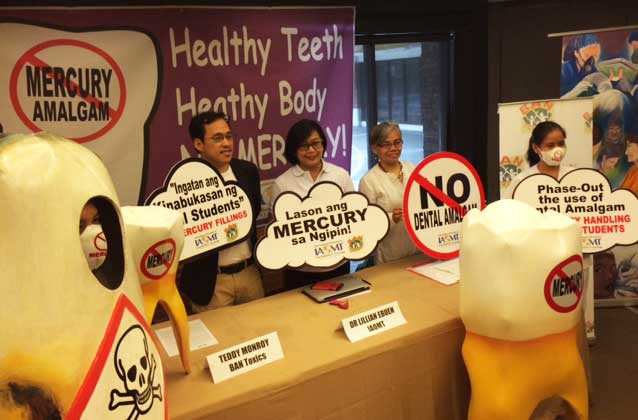
Quezon City, 05 July 2016—The campaign for mercury-free dentistry in the Philippines gained ground today as a broad coalition of dental and health professionals, environment workers and social justice advocates joined to call for the urgent phase-out of mercury-laden dental amalgam.
Emphasizing safety and environment concerns, the group, led by BAN Toxics and International Association of Oral Medicine and Toxicology (IAOMT), stressed that with the continued use of dental amalgam fillings, efforts to comply with the Minamata Convention and to control mercury pollution in the country will be compromised.
“Scientific evidence-based research shows that mercury vapors can be emitted by amalgam fillings,” said Dr Lillian Ebuen, DMD, of IAOMT. “The phase out of dental amalgam in the Philippines is inevitable. A short timeline will enable a quicker shift away from a centuries-old toxic technology and will open more doors for greater progress on safe and healthy dental fillings, helping advance the field of dentistry.”
“Mercury pollution is a problem that needs a comprehensive solution,” said Teddy Monroy, Policy Development, and Research Manager. “By banning the use of mercury in small-scale mining as well proposing a 2020 phase-out timeline for other sectors, the Philippines is making steady progress in mercury reduction. But its use by the dental profession also needs to be phased out under the same 2020 timeline to close all windows for illegal mercury trade within the country and to prevent the country from becoming a dumping ground of mercury we have no capacity to deal with.
“It is also crucial that the Philippines ratify the Minamata Convention soonest. Once it enters into force, the global flow of mercury will follow the path of least resistance. The entry of mercury as dental amalgam is a big hole that needs to be plugged,” he added.
The Philippines is one of the countries taking a leading role in ensuring protection of the environment from mercury emissions. After signing the Minamata Convention in 2013, the government is in the process of updating the existing Chemical Control Order (CCO) for Mercury and Mercury Compounds. The proposed new CCO for mercury will include a provision on a timeline for the phase out of dental amalgam which is exempted from regulation under the 1997 CCO.
Dental amalgam fillings, erroneously known as “silver fillings”, is composed of 50 percent mercury and has been the dominant dental restorative material for the past century. With neurotoxic mercury as the main ingredient, concerns regarding its safety have been raised. Mercury vapors are also emitted during the preparation of the amalgam, endangering the health of dental professionals and students, as well as patients. After application on the tooth, excess amalgam is frequently disposed in wastewater, contaminating water systems with mercury. Dental fillings use more mercury each year than lighting electrical devices or measuring devices[1] and is a major source of mercury pollution in waterways.[2]
A 2013 report by the United Nations Environment Program (UNEP) cites that dental amalgam, through cremation and solid wastes, contributes significantly to global and local mercury pollution.[3] Likewise, a report by IAOMT-Philippines and BAN Toxics[4] shows significant mercury vapor emissions coming from dental clinics, schools and dental supply shops, thus posing a risk to both patients and dental health practitioners.
According to the latest dental health survey by the Department of Health (DOH), 87.4 percent of the Filipino population suffer from dental caries. Another recent study places caries rate at 98% and estimates that 7 million Filipinos have never seen a dentist. Opponents of a dental amalgam phase-out cite the country’s caries rate as a basis to continue using amalgam due to its low cost. But to propose dental amalgam as an “affordable solution” for the poor despite its toxicity runs counter to the principles of human rights. And proposing to treat the millions of cases of cavities with dental amalgam will mean corresponding massive mercury vapor emissions and mercury contamination of waterways.
Reflecting on these factors, the group found that issues such as poverty, the lack of access to basic dental health care, and the inaccessibility of mercury-free dental treatments as crucial aspects in developing a comprehensive plan on dental mercury. The group is calling for the phase-out of dental amalgam with a 2020 end date and for government programs that will allow an easy transition to mercury-free dentistry.
The group is calling on the government to protect the rights of the Filipino people and dental workers to safe, environment-friendly, and mercury-free dental procedures. Among these is the provision of basic dental health care and education to low-income groups, training support for current dental practitioners on mercury-free restoratives through continuing program education by the government and other key experts, training of Filipino dental health workers on amalgam safety protocols, and to overhaul the current dental curriculum to remove dental amalgam laboratory and clinical training as a requirement for dentistry students.
Health is a trade union issue and health care is at the heart of quality public service, which is consistently pushed by public sector unions,” said Erma Montebon of Public Services Labor Independent Confederation (PSLINK). “Ang usapin sa phase out of dental amalgam ay kaakibat ng usapin sa decent work, a primary campaign of PSLINK; at sa usapin sa decent work hindi lamang natin concern at isinusulong ang equitable pay at social benefits kundi lalo lalo na ang occupational safety and healthy working conditions and circumstances.”
Promoting best practices in achieving a caries-free nation and avoiding mercury dental fillings would promote a nationwide oral awareness campaign. Alternatives to mercury fillings are available, affordable and safe for the community and the environment,” said Dr Ebuen.
The solidarity group to achieve mercury-free dentistry in the Philippines is composed of the following: The International Association of Oral Medicine and Toxicology (IAOMT) – Philippines, BAN Toxics, Public Services Labor Independent Confederation (PSLINK), and the Philippine Society of Clinical and Occupational Toxicology (PSCOT).
Notes to editors:
[1] http://www.chem.unep.ch/mercury/Atmospheric_Emissions/Technical_background_report.pdf
[2] http://www.epa.gov/hg/dentalmalgam.html
[3] http://www.unep.org/PDF/PressReleases/GlobalMercuryAssessment2013.pdf
[4] http://bantoxics.org/download/What’s%20Up%20In%20The%20Air.pdf
